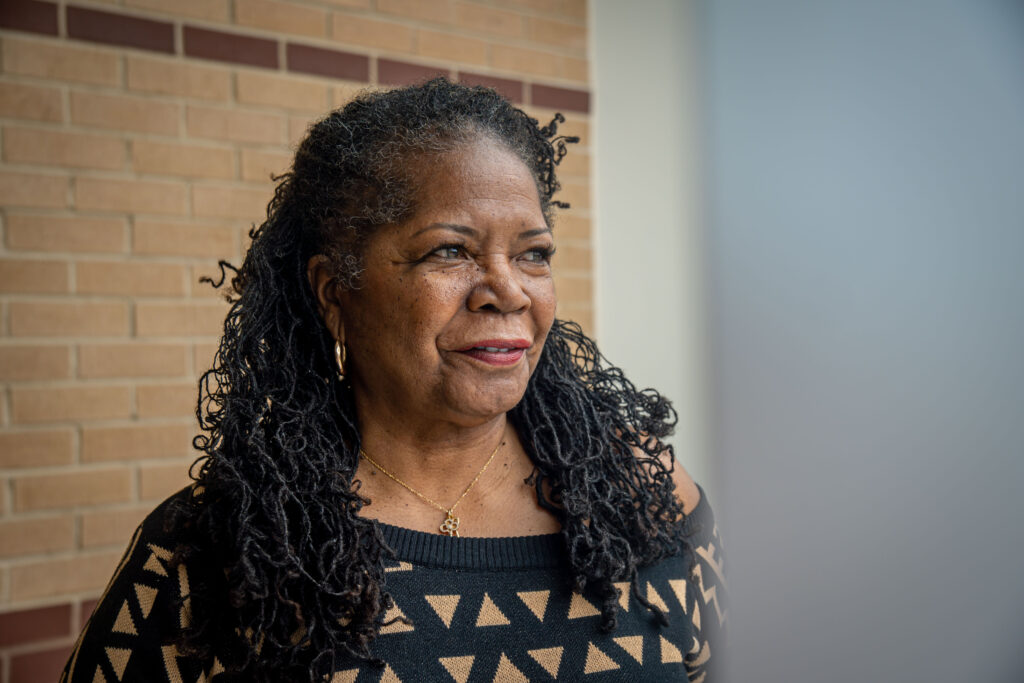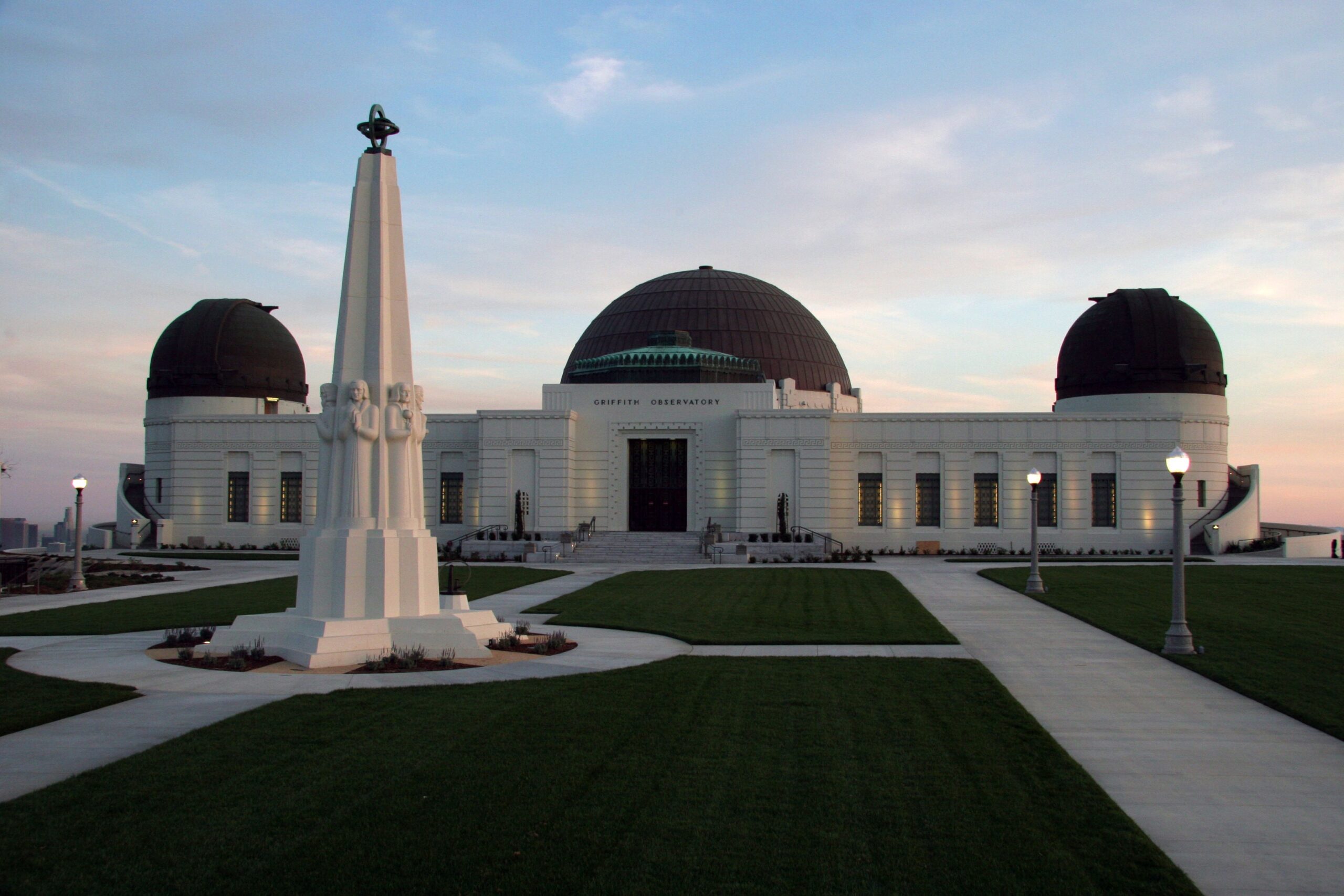ENGLEWOOD, N.J. — It was the early 1980s. On any given Sunday, over the loud horns and hustling New Yorkers, you would hear Hal Jackson on WBLS, hosting his top-rated “Sunday Classics” morning show, playing records by everyone from Prince to Michael Jackson and Whitney Houston, at a time when Black artists still struggled to break through mainstream airwaves. Each week, whenever Hal gave away CDs or concert tickets on air, his wife of then-15 years, Debi B, would be on phone duty, writing down winners’ names on a sheet of paper and handing it to Hal to announce.
One day, he asked her to make the announcement.
“I said, ‘Huh?’” Debi B recalls. That day, she felt more like a partner than a sidekick. “And that was the beginning of my radio career. The music he played was the old, and I would bring in the new.”
By then, Hal had made history as the first NYC personality to have daily radio shows on three separate stations. He was the first African American play-by-play sportscaster and the first Black network radio announcer. Hal knew he wanted to marry Debi within six weeks of dating. Six years later, they did. Together, for the next four decades, they made the city their stage. The power couple’s marriage lasted 31 years until Hal’s passing in 2012.
Last year, Debi was in their home in Englewood Cliffs, N.J., flipping through over 400 photos of Hal alongside music icons like Luther Vandross, Tina Turner, Nat King Cole, Boyz II Men, and Lionel Richie. That’s when Helene Cohen, the Community Outreach and Gallery Curator of the Bergen Performing Arts Center (BergenPAC) in Englewood, New Jersey, called and encouraged Debi to do a photo exhibit to celebrate Hal’s legacy. Months later, on the night of Feb. 19, Debi did just that with the opening of “The House That Jack Built: The Many Friends of Hal Jackson,” which aims to amplify Hal’s legacy of breaking racial barriers and uplifting Black voices in the media.
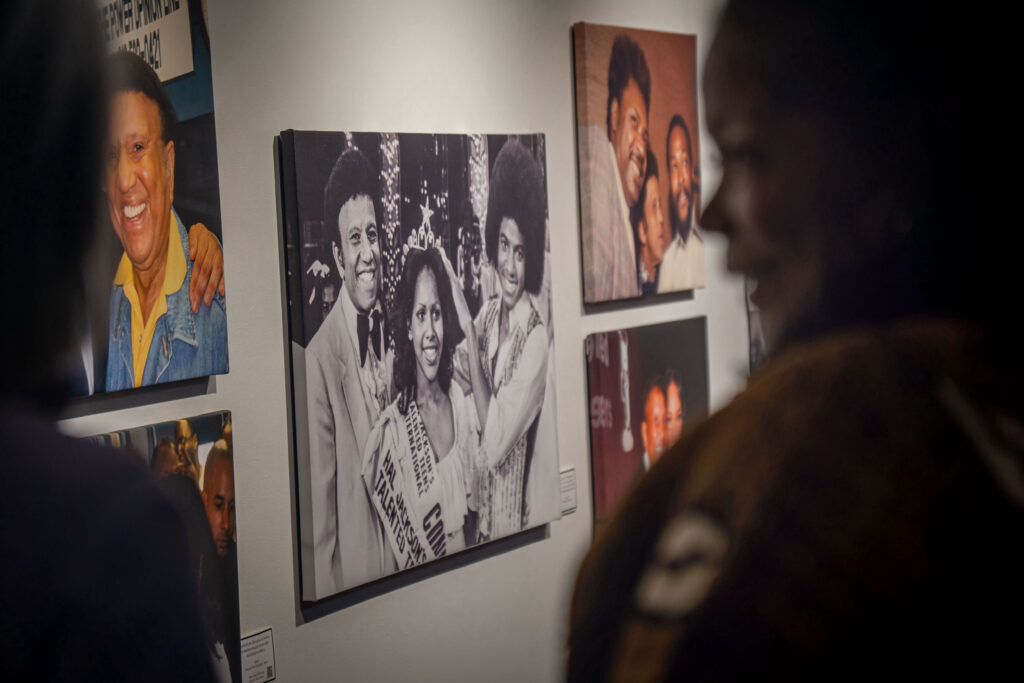
Debi B Jackson talks to a guest at the House That Jack Built: The Many Friends of Hal Jackson exhibit at the BerganPAC. [Photo Credit: Lynise Olivacce]
“He would always say, ‘Deb, you’re doing such a great job,’” she remembers. “He was the person who would say, ‘You can do it. If you have a dream, just go after it.’ And he would push you along.”
As a photographer herself, Debi didn’t just want photos for the exhibit. She wanted stories that would send people down memory lane. As she scrolls through a set of images she snapped from the 1930s to 2000s, she stops at one of Hal with Janet Jackson. Debi recalls when she and her late husband were dating, working out of his office at 3 Park Avenue.
“We were in the penthouse and the next floor down, and [Janet] was upstairs in the studio,” she says. “And I said, ‘Hey Jack, Janet’s upstairs. He said, ‘Really?’ I said, ‘Come on, let’s go see her.’ I always had my camera. Always. So we went, and she was looking out the window because the view was spectacular from there. Then she turned around, and she saw him.” Debi mimics Janet, audibly gasping. “She ran across the room and threw her arms around him.”
Hal had similar interactions with Whitney Houston and Michael Jackson. As much as he was known for his monumental work in radio, it was his kindness that left a lasting impression. Debi B recalls one of his favorite sayings: “It’s nice to be important, but it’s important to be nice.”
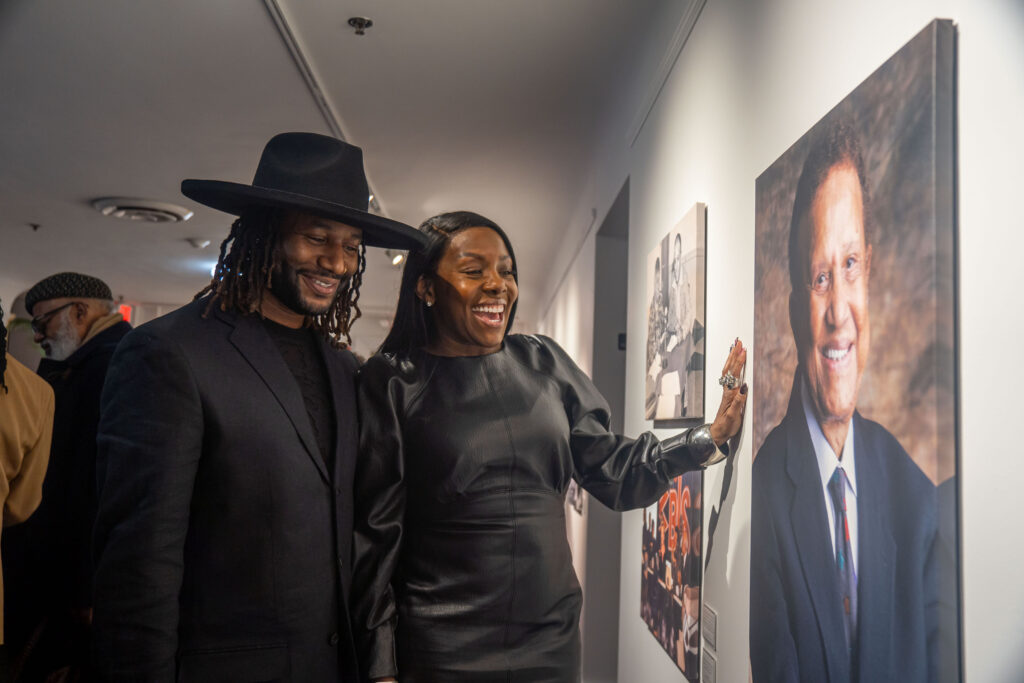
The R&B and neo-soul duo, “Koffee Brown,” admires a photo of Hal Jackson at The House That Jack Built: The Many Friends of Hal Jackson at the BerganPAC. [Photo Credit: Lynise Olivacce]
“We didn’t know we were doing it,” says Debi B. “We just knew we were playing music we liked, and it became an anthem. It became a habit. We would go to concerts and go backstage. That’s the thing that I miss about radio—the perks that come along with it. You get to meet a lot of different people.”

The House That Jack Built: The Many Friends of Hal Jackson exhibit at BerganPAC. [Photo Credit: Lynise Olivacce]
Born and raised in Harlem, Debi B grew up in a fifth-floor tenement on 116th Street where she would play in the hallways and on the fire escape. She grew up, as she puts it, “sheltered and shy.”
“I think that’s what made me into the person that I am today,” she says. “I look at the good side of everything, as a matter of fact, sometimes to a fault. People who do me wrong – I just keep moving. I don’t hold a bunch of grudges. I know I have God on my side.”
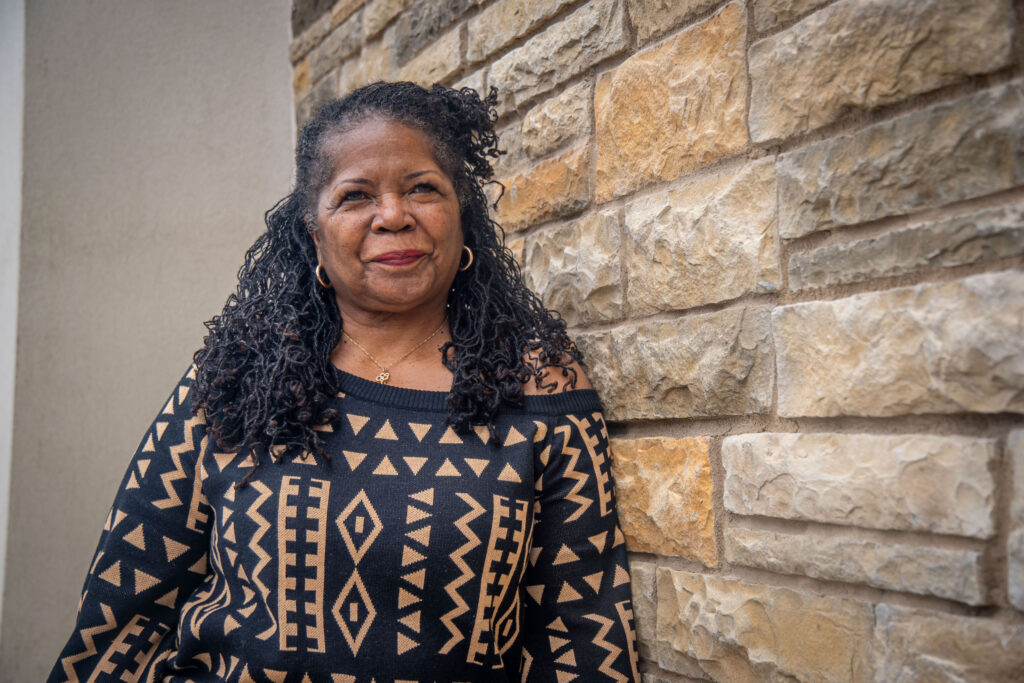
Debi B Jackson poses against the brickface wall at Community Baptist Church for a portrait. [Photo Credit: Lynise Olivacce]
“Susan Taylor from Essence magazine also lived in that building, on the second floor on the front of the building,” Debi tells me. At age 12, she took up photography, always with her Kodak camera in hand. “My father and my mother had Polaroids, and we have pictures, pictures, and pictures.” Debi points to her father’s camera beside her. “There was always a camera around. I just started taking pictures.”
Debi never stopped snapping photos, leaning more towards landscape photography. Her work caught the attention of Willie Walker from the Adam Clayton Powell Jr. State Office Building in Manhattan.
“He saw some of the pictures and said, ‘You have a great eye. You need to do an exhibition,’” Debi recalls. She went on to become the first solo artist to showcase at the venue. “Took up the whole space, and that was something,” she says. “I did it there three years in a row because of him, so I gotta give him props.”
In the early-to-mid-80s, Debi worked as the Assistant Director of Affirmative Action at Fairleigh Dickinson, but then found herself out of work after pulling a ligament in a skiing accident in Colorado. At that point, Hal told her, “You don’t need to work anyhow.” His unwavering support allowed Debi B to step away from working a nine-to-five in 1989. She then worked with Hal full-time and immersed herself in photography. Hal’s support also deepened her desire to honor the man who always put others first, ensuring his warmth and legacy live on.
“I hope for people to appreciate the warmth and impact of Hal’s life and contributions through the exhibit,” Debi says.
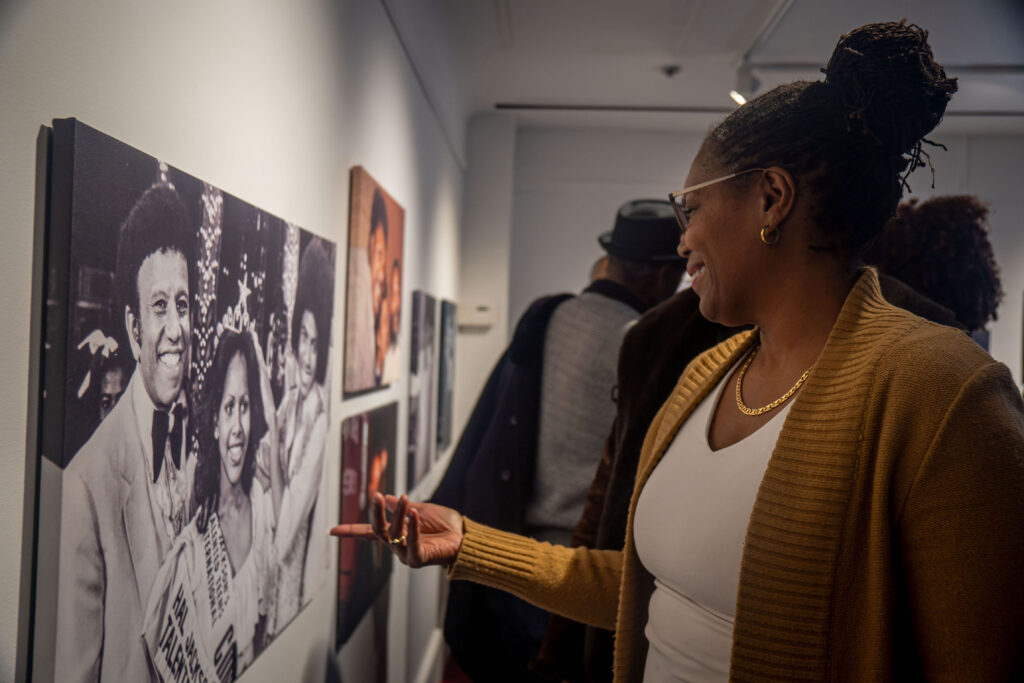
Tonya Bolling admires a picture of her father at The House That Jack Built: The Many Friends of Hal Jackson exhibit at the BerganPAC exhibit. [Photo Credit: Lynise Olivacce]
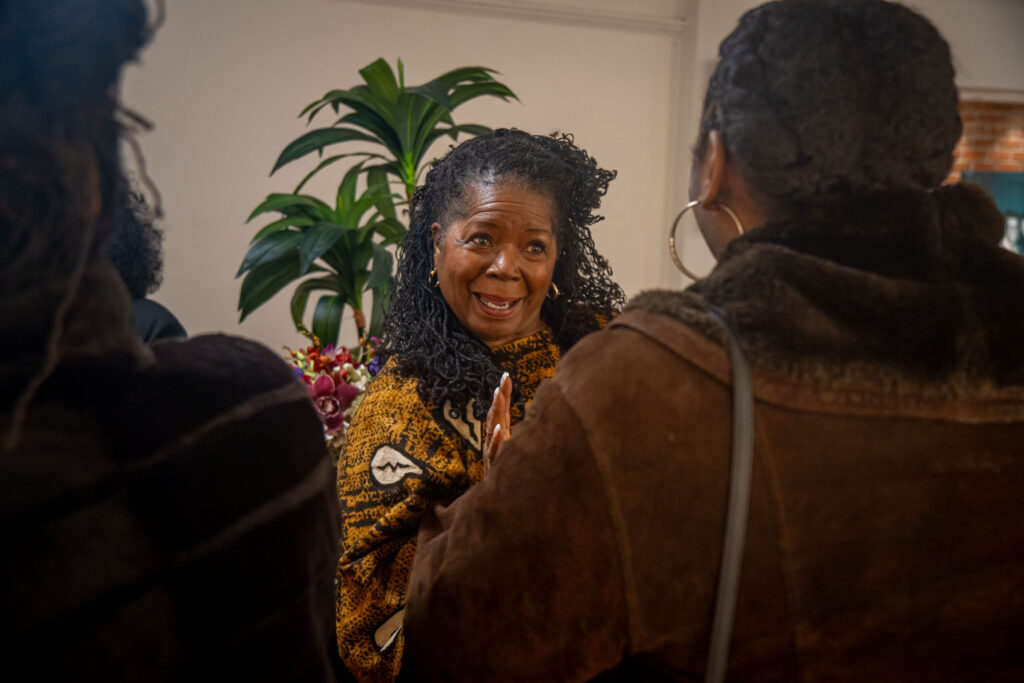
Debi B Jackson beams in the middle of the House That Jack Built: The Many Friends of Hal Jackson exhibit at the BerganPAC as she talks to few guests. [Photo Credit: Lynise Olivacce]
As the event draws to an end, Debi grabs a mic, gathers everyone, and thanks them for being part of honoring Hal’s legacy. “I’m so proud of how the event turned out,” she says. “I know he is watching. I am so honored to keep Hal Jackson’s legacy alive, and I’m just getting started.”
Just as Hal once invited Debi B to step up to the mic on Sunday Classics, she’s carving her own space to keep the music alive. Starting at just once a month on Wednesdays, Debi will be launching “Intimate Sessions,” a show featuring R&B and Jazz. Debi B has an old 2001 car that she takes out to drive here and there and recalls a few CDs she put together.
“It’s a different blend of music,” Debi says. “And every time I take that car out and I listen to those CDs, I keep saying, ‘This is what other people need to hear.’”
